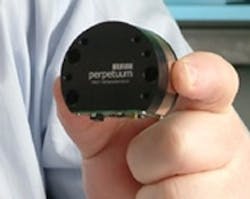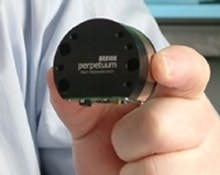New microgenerator could make battery-free wireless sensors a reality
Perpetuum's microgenerator reportedly converts kinetic energy from the vibration of equipment running into electrical energy.
The company says the microgenerator converts kinetic energy from the vibration of equipment running at 50 or 60 Hz into electrical energy. It can generate up to 5 mW–enough to power a wireless transmitter sending up to 6 Kb of data every few minutes, or smaller amounts of data, such as a temperature reading, several times a second. Perpetuum says it can operate in most industrial environments and at minimal vibration levels (25 mg).
The device allows operators to continually monitor plant equipment, providing valuable data such as temperature and vibration spectra about the condition of equipment that could include pumps, motors, and blowers. That data can be used to optimize the efficiency and availability of a plant, increase the cost-efficiency of maintenance work, prevent accidents and obtain significant savings in energy costs.
RLW Inc., of State College, Pa., selected the Perpetuum microgenerator to power its wireless sensor nodes. These devices have been used, say Perpetuum officials, to demonstrate that the device can provide the necessary energy for even the most demanding sensor applications such as accelerometers.
“This is a major breakthrough in the technology,” claims Roy Freeland, CEO, Perpetuum. “We are delighted to be in a position to now offer this product to the market, having successfully completed field trials for the U.S. Navy, an international oil company, and Yorkshire Water (UK). This is a practical device, not a laboratory experiment.”


